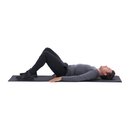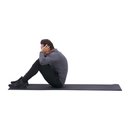Remember back in grade school P.E. class when the gym teacher had all the students see how many sit-ups they could do? I do.
In third grade it was the day for the sit-up test during physical fitness week. (Some kids were conveniently "sick" that day.) Our class walked into the gym and one of the second graders from the previous gym class was still going strong.
He ended up doing more than 700 sit-ups and his face was beet red when he finished. I ended up doing around 90 and the next day my stomach muscles were so sore I could hardly breathe. I've always wondered how that other kid felt the next the day! I share that story because unwittingly that day was my introduction to a lifelong training regime for my midsection.
Conditioning the muscles of the abdomen and lower back has had many terms during my 25-plus years of working out. As a kid, it was called exercising the stomach muscles.
In the 80s, it was abdominal training and ab work. During the late 90s and still today it's called training your "core", which now also includes the lower back. So what constitutes core training and why is there a big craze about it in the fitness industry? Let's find out.
What Is Core Training?
The area of the body, which is commonly referred to as the core, is your midsection and it involves all your muscles in that area including the front, back and sides. The core includes the traverse abdominis (TVA), erector spinae, obliques and your lower lats.
These muscles work as stabilizers for the entire body. Core training is simply doing specific exercises to develop and strengthen these stabilizer muscles.
If any of these core muscles are weakened, it could result in lower back pain or a protruding waistlines. Keeping these core muscles strong can do wonders for your posture and help give you more strength in other exercises like running and walking.
Why Core Training?
You've probably noticed the big push for core training at health clubs and in many fitness magazines. Many clubs will offer specific classes on core training alone.
Why is this type of exercise getting so much attention? Americans are increasingly getting more and more sedentary.
Many of us have office jobs and sit eight to nine hours a day. Add another hour or two of driving time and that adds up to a lot of sitting. Prolonged sitting and no exercise weakens the muscles of your midsection.
Our ancestors didn't need to think about core training because they worked hard from sunrise to sunset doing labor-intensive chores.
The fitness industry has recognized this and is trying to show people how to keep their bodies strong despite the amount of sitting we do each day. Keeping the torso strong is important because it is the body's center of power.
Who Is Core Training For?
Core training is for EVERYONE!
Keeping the body's stabilizer muscles strong will not only improve an athlete's performance, but it will help in life's everyday tasks. Bending, reaching and twisting are movements we do everyday. It could be picking up a pencil or reaching to fasten the seat belt.
The last thing anyone wants, including hard-training athletes, is to blow out their back by picking up a two-year-old child off the floor. It can happen but if the core is kept strengthened, there's less of chance of sustaining an injury from an everyday chore.
I recently saw a commercial on TV where a guy with a pot belly is getting something out of the refrigerator. He turns and looks out the window and sees his beautiful neighbor inside her apartment and she's looking at him. He immediately sucks in his stomach. When she looks away he lets it stick out again.
Guys like this REALLY need to step up the core training. They also need to drop a few pounds of fat from the midsection as well. Carrying excess weight around the belly can ruin your posture and weaken the muscle of your lower back. To remove that fat, follow a healthy eating plan and limit your calories and carbohydrate intake.
To speed things up even further, try one of the many ephedra-free fat burners that are available. I like VPX Redline and AST Dymetadrine Extreme.
Benefits Of Core Training!
Bodybuilders especially need a strong core. Heavy squats, deadlifts and barbell rowing give the core a challenging workout by themselves, but doing additional abdominal and oblique training helps to alleviate the injury factor. Handling the heavy poundages that are necessary for mass building requires a very strong midsection.
The added benefit of incorporating a new and challenging workout to your routine can enhance your overall progress by igniting newly developed motivation.
If your training is in a lull, concentrating on exercises for the torso is a good way to spark the enthusiasm once again. Think of yourself as Rocky when he was doing inverted sit-ups in that Russian barn! It makes you want to head to the gym right now doesn't it?
Incidentally, another reason for core training is a beloved side effect that comes from it. That side effect is a dynamic six pack, which gets plenty of attention at the beach!
A ripped six pack also gets lots cheers when you're on a bodybuilding stage also.

BodyFit
$6.99/month- 2,500+ expert-created single workouts
- 3,500+ how-to exercise videos
- Detailed workout instruction
- Step-by-step workout tips
- Training at gym or at home
- Access to Workout Plans
- Access to Bodyfit App
- Store Discounts
Already have a Bodybuilding.com account with BodyFit? Sign In

What comes with BodyFit?

- Instructional Videos
Don't risk doing a workout improperly! Avoid injury and keep your form in check with in-depth instructional videos.

- How-to Images
View our enormous library of workout photos and see exactly how each exercise should be done before you give it a shot.

- Step-by-Step Instructions
Quickly read through our step-by-step directions to ensure you're doing each workout correctly the first time, every time.
In order to strengthen your core remember to stimulate, don't annihilate! Begin by performing 10 to 15 repetitions of each exercise. Do them two or three days per week on non-consecutive days.
After a couple weeks go through the cycle of exercises two or three times. Staying consistent and doing a little is more beneficial than doing too much every once and a while.
Advancing The Workout
Once you've mastered these exercises, try some new ones. Many can be found in bodybuilding and fitness magazines. Throw in some hyperextensions on your back days.
Conclusion
Keep variety in core training. There are lots of little muscles in your torso that only get worked from certain angles.
And remember it's always best to get the green light from your doctor before engaging in any exercise plan.
When he or she does give you the go ahead, try these exercises and maybe your core will get strong enough to handle one of those hour-long core training classes offered at the club.




